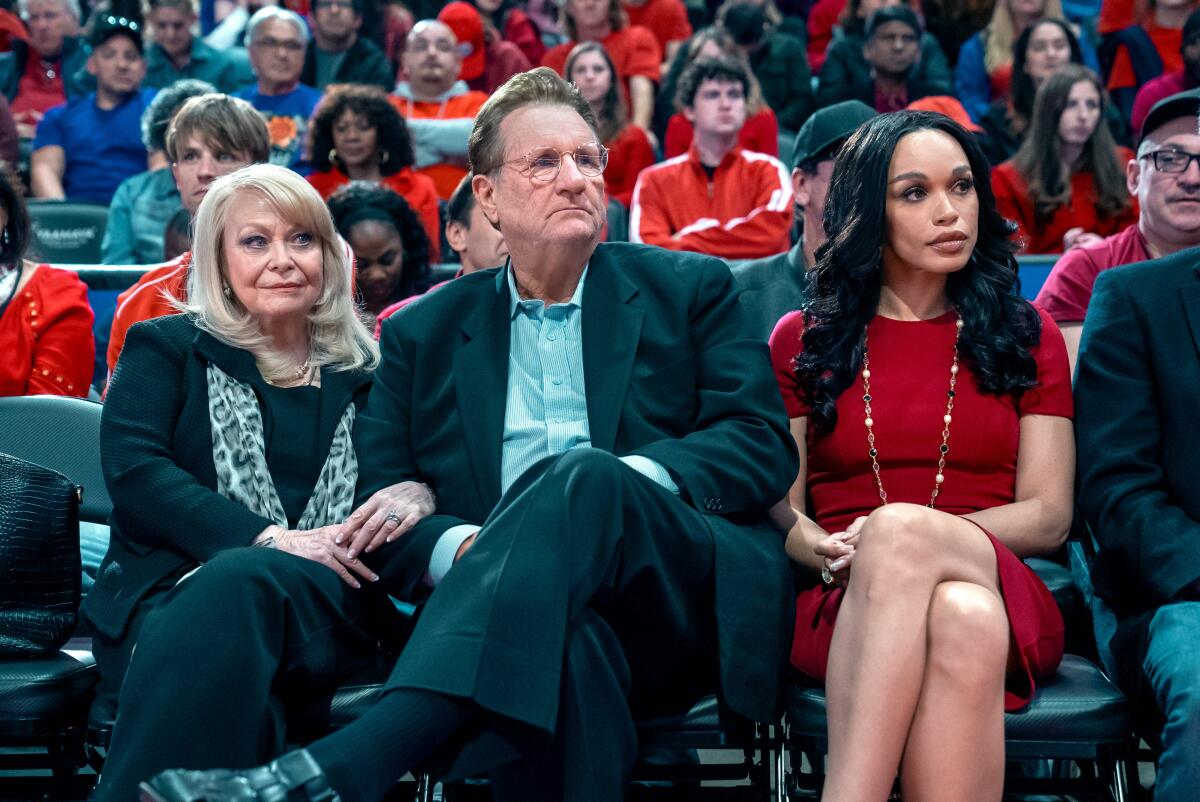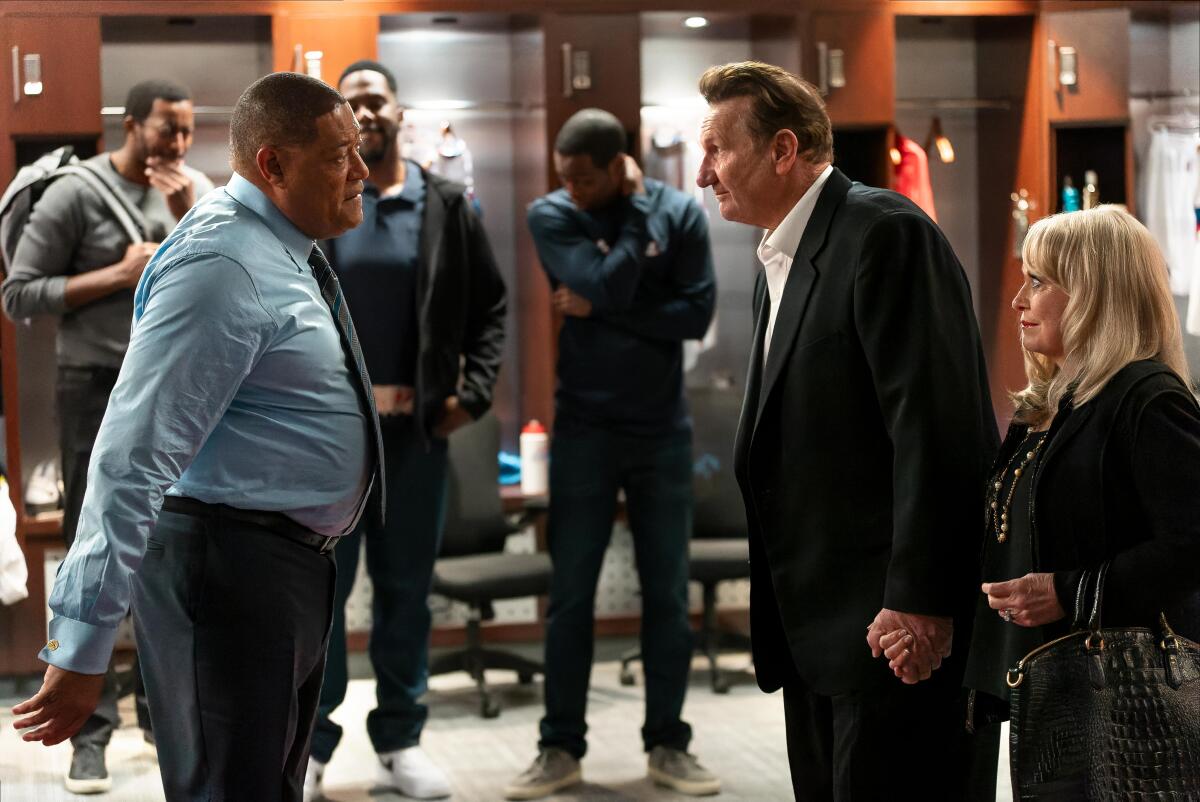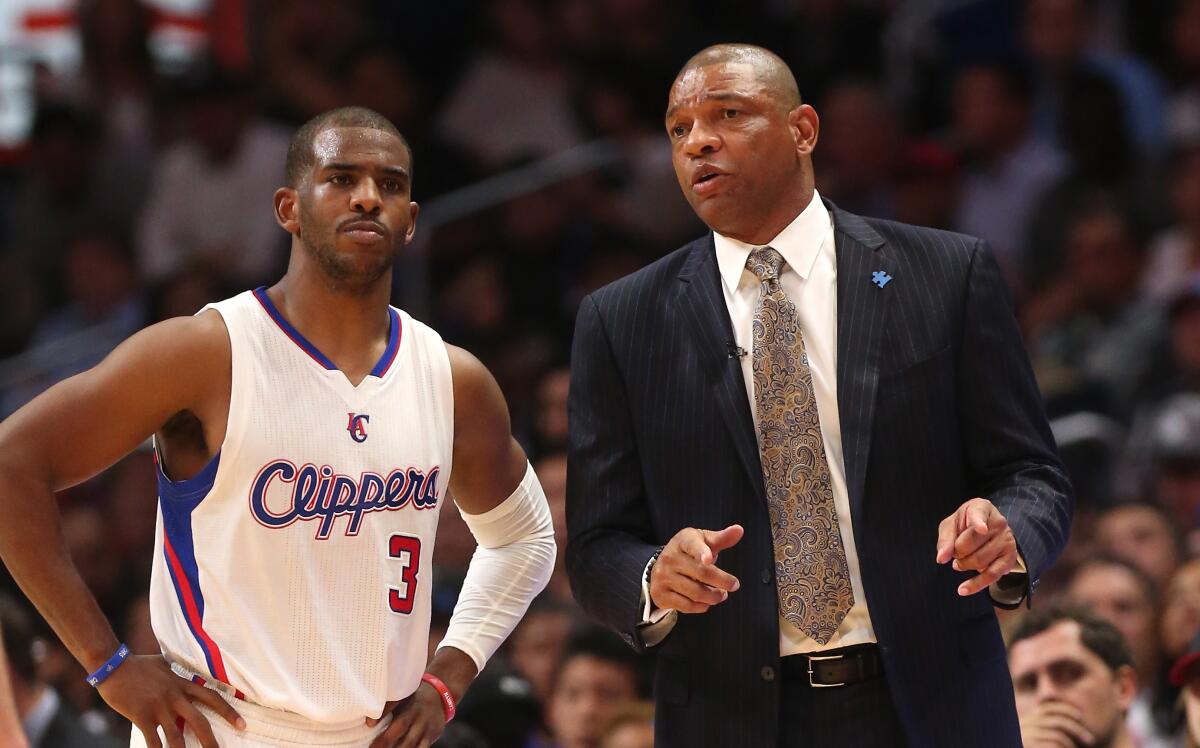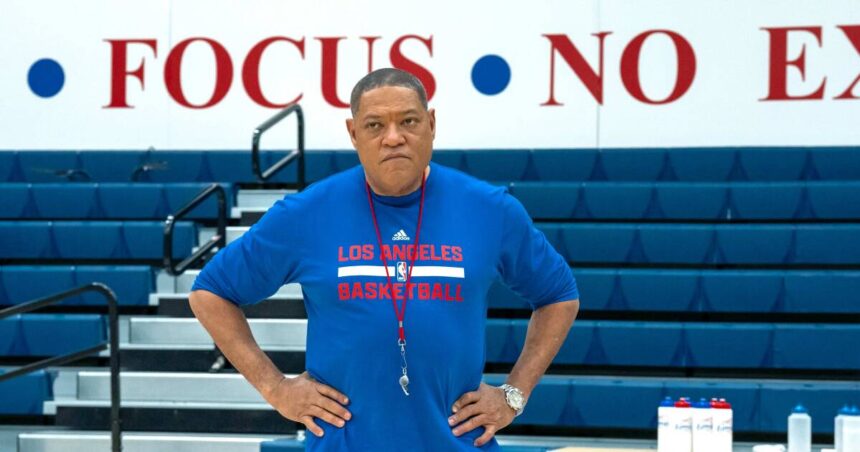The new Hulu series “Clipped” offers a dramatic look back at the Donald Sterling scandal, during which recordings by V. Stiviano exposed the former Clippers owner’s racist remarks and triggered explosive fallout.
Times writers Ben Bolch, Bill Plaschke and Dan Woike covered the Sterling saga and help us fact check the new show. Plaschke had a brief cameo in the show, which was based on Ramona Shelburne’s ESPN podcast series.
Ed O’Neill, who is well known for his roles on “Married With Children” and “Modern Family,” tackled the role of Donald Sterling during the series. Did he deliver a reasonably accurate version of the Sterling you saw while covering the Clippers?
Bolch: Sterling had a more firm, menacing presence — you felt uncomfortable just being in the same room with him. O’Neill captures the buffoonery to a large extent but seems a touch more jovial than the man he portrays. Writers missed the opportunity to add another layer to his character by failing to dedicate one of the show’s flashbacks — probably the best part of the series — to a young Sterling to demonstrate what went into making him such a hateful person. O’Neill doesn’t make Sterling as unlikeable as he is in real life, which is troublesome given that he’s the show’s primary antagonist.

Jacki Weaver as Shelley Sterling, from left; Ed O’Neill as Donald Sterling; and Cleopatra Coleman as V Stiviano in “Clipped.”
(Kelsey McNeal/FX)
Plaschke: Ed O’Neill is terrific as Donald Sterling. Eccentric, bombastic, sleazy, completely unaware of how the world viewed him. I actually attended the White Party that was so vividly portrayed in the first episode, and it perfectly captured the way he ruled over his kingdom of young women and business sycophants. I brought my then-girlfriend to the party and Sterling hit on her. Seriously. After she pulled herself away from him, she was like, “At least that man has good taste!” This scene was so well filmed, I was transported back to that moment, and once again I felt, like, ick.
Woike: O’Neill’s version is more pointed and focused, maybe a little less eccentric, than the version of the man I remember being around the team at this stage. Sterling never carried himself as acerbic in my dealings with him. There was more feebleness. This portrait is sharper with the gross stuff turned up to 11. But at the core of this, there’s a person who cares about himself and his position more than others — people of different races, different classes, his players, his employees, his wife etc. — and O’Neill certainly captures that. The real guy is just so weird – in addition to all the hatefulness.
No character portrayed in the series has spent more time on television than Doc Rivers. Laurence Fishburne has a different body type than Rivers, but did he reasonably capture the former Clippers coach’s personality and reaction to the Sterling scandal?
Woike: In the aftermath of the Sterling tapes, Doc Rivers moved even more to the foreground — in basketball, in the organization. He handled the situation as well as someone could’ve and I think that comes through in the show. He was built for it, and that’s here. It’s a strong performance.
Bolch: The most authentic, nuanced performance in the series belongs to Fishburne. He captured Rivers’ essence down to the fit of his dress shirts, his facial expressions and his sandpapery voice. Fishburne also replicated Rivers’ ability to shepherd the Clippers through the scandal — as well as the toll it took on him — in convincing fashion, especially during the ballroom meeting with the players as they decided whether to keep playing. His commanding presence and ability to vacillate between one-liners and earnest remarks also reminded me a lot of the way Rivers conducted himself.
Plaschke: Like O’Neill, Fishburne is great. He has Doc’s look, Doc’s walk, Doc’s voice. And it’s amazing because, in meeting Fishburne on the set while I shot my brief scene, it became clear he knew nothing about Doc Rivers, knew nothing about the Clippers, couldn’t even name more than a couple of them. He apologized to me for not being a sports fan, but I was so impressed he wasn’t a sports fan yet still tackled this role. And he tackled it brilliantly.

Laurence Fishburne as Doc Rivers, from left, looks at Ed O’Neill as Donald Sterling and Jacki Weaver as Shelley Sterling during the Hulu series “Clipped.”
(Kelsey McNeal/FX)
What was the atmosphere like immediately after the audio recordings of Sterling’s racist comments were first released and did the show capture that moment well?
Plaschke: It was an off day in the series and I was visiting my brother in Napa Valley and my brief respite became a total nightmare, everybody in L.A. going crazy, everybody in the NBA going crazy, I’m typing a column on a folding table on a porch in wine country and then rushing back to the Bay Area for the madness.
Woike: Chaos. Total chaos. You went from covering a basketball series to covering one of America’s greatest shames — its racist past and present.
Bolch: It was complete mayhem. The media horde waiting to get into the Clippers’ practice at the University of San Francisco was eager to hear what Rivers and the players had to say about Sterlings’ remarks. Rivers decided he would be the only one to talk — and spoke emphatically about the team’s collective disdain for what was said. It was one of his most impressive moments during the whole ordeal, showing his ability to navigate pressure on the fly. This scene was oddly left out of the show, which amounts to a huge opportunity lost.
Did anything stand out in the first few episodes as inaccurate compared to your experience covering the Clippers scandal?
Bolch: The show captured the essence of the scandal but doesn’t really hit its stride until the last three episodes, where the character backstories are revealed and new ground is covered that may not be known to those who casually followed the ordeal. This was the most compelling part of the series and some viewers may not make it there given the earlier episodes are more uneven. If you are the slightest bit intrigued by what you’ve seen by the end of Episode 3, keep watching.
Plaschke: The show has two main drawbacks … first, Blake Griffin is NOT Blake Griffin. He doesn’t look like him, doesn’t sound like him, doesn’t act like him, not even close. I remember seeing the actor on the set and wondering, who is he playing? When somebody told me he was Blake, I was like, they must do a heckuva job on him with props and costumes and makeup. Well, they didn’t. He’s a fine actor, he’s just badly miscast. The second mistake is a lack of attention to the basketball scenes. They were so good in “Winning Time,” maybe we’re spoiled, but at least in the early episodes, the basketball play is chopped up and hard to follow and pretty awful.
Woike: The portrayal of Blake Griffin seems way off to me — someone who I never viewed as a selfish teammate or as a Sterling lapdog. Seems totally fabricated to me. Especially the introductions. Also, V. Stiviano comes across as maybe a little too normal here than any of us around at the time thought.
The general ickiness of this is pretty on point. The basketball/casting stuff is what it is, the show having the misfortune of airing this closely to the doppelganger work “Winning Time” did in its two seasons. I think, generally, it’s close enough. Some character traits are turned up too loud. Any heroism assigned to Shelly Sterling also doesn’t sit great with me. Not a lot of heroes in this story.
Did anything you saw during the series surprise you? Was there anything you wished would have been handled differently to better reflect that period of the Clippers era?
Plaschke: Chris Paul versus the rest of the team should have been highlighted. That was the theme that eventually brought down Lob City. And CP3 actually looks and sounds like CP3. I would have also liked more of Seth Burton. The public relations guru is played by a great actor, and I wanted to see more of Burton’s incredible tight-rope walking as he handled this craziness.
Bolch: Tensions between Chris Paul and the rest of the team were alluded to in the first episode but never developed. That could have been another thread in the show that heightened the drama and revealed more behind-the-scenes dissension that prevented the Clippers from maximizing their potential. J. Alphonse Nicholson’s portrayal of Paul is good enough to warrant more screen time.

Clippers coach Doc Rivers talks to point guard Chris Paul on the court during the 2015 NBA season.
(Getty Images)
Woike: I think just how “normal” Donald Sterling, Shelly Sterling and V. Stiviano all seem — which probably speaks to just how strange those people. For the people who were around them, it’s just so hard to explain how strange they all were.
This remains a dramatization of the Sterling scandal and the creators never promised the audience a documentary. Still, the real saga was salacious enough to capture a lot of attention. Overall, how would you grade the show’s accuracy?
Bolch: The accuracy as far as the scandal’s timeline goes is spot on, but I’m not sure the well-known plot or the characters — besides Fishburne as Rivers — make this dramedy all that riveting. Most of the scenes involving V. Stiviano and Donald Sterling feel like whimsical caricatures compared to the gripping tension whenever Rivers takes center stage. The writers might have been better served to fully commit to a send up or go the other way and make the Sterlings more abominable figures that you can’t stop watching because you need the relief of their forced sale of the team. As it stands, “Clipped” is sort of like the team it portrays — never quite reaching the intended destination.
Plaschke: With the exception of Blake Griffin, it feels pretty accurate. I love the way it uncovers the real V, I think Shelly Sterling’s character is spectacularly spot-on and Ed O’Neill does a remarkable job pulling back the curtain on the real Donald. And the main takeaway for all Los Angeles sports fans should be obvious. Think about it, for the first time ever, THE CLIPPERS ARE ON TV IN JUNE!
Woike: If the story is about the key factors in play, the firestorm it caused, the public airing of Sterling’s plantation mentality and Doc Rivers and the Clippers players resolve through this mess, it’s a hit. But the dramatized parts — the way some employees were made to seem like bumbling morons, the way Griffin was portrayed (he’s going to have some of the biggest gripes) — don’t land for me as someone who was there every day. In this case, the truth — and the work done by people on that front — is more compelling than the fiction.

